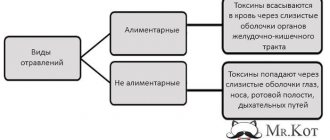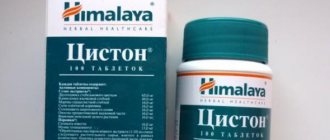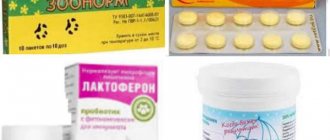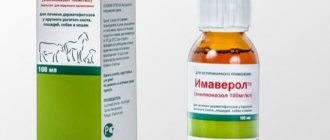Pain is the body’s physical response to damaging factors. Pain syndrome makes it necessary to avoid exposure to such factors if possible, but at the same time pathophysiological processes develop that cause harm to the body: blood pressure rises, sugar and cortisol levels increase, and breathing may be inhibited. Severe pain can cause shock and lead to death. Therefore, it is necessary to deal with pain not only for humane reasons, but also for medical reasons. The fact that an animal is in pain is indicated by a change in its behavior.
Pain threshold in cats
It is generally accepted that our pets have a low pain threshold, that is, a high susceptibility to unpleasant sensations. This is far from true.
Felines tolerate pain very easily. And the perception of such a sensation in animals is somewhat different than in people.
But this argument does not mean at all that various manipulations can be performed on the animal without the use of painkillers.
When is pain medication needed? In medical practice, there are a huge number of manipulations that involve taking painkillers. But only a doctor has the right to prescribe this or that drug for use . He will correctly calculate the dosage and time of administration.
Only a doctor has the right to prescribe a painkiller for use.
As for manipulations, drugs are most often needed during surgical interventions.
- Every second cat is sterilized. It requires the presence of strong painkillers. But styling is not the only procedure that requires preparation of the animal.
- Cats suffer from urolithiasis.
- The gastrointestinal tract ceases to function.
- Some cats and female cats are declawed. This procedure is not performed without general anesthesia.
- If the animal has serious mechanical injuries, the stitching of the tissues will initially be carried out using special means.
For the first time, an anesthetic is used in the presence of a veterinarian. In the future, you can independently administer drugs to the animal on the recommendation of the treating veterinarian.
Causes of pain and symptoms
Various factors and circumstances can cause pain in dogs and cats. These include :
- injuries - wounds, dislocations, fractures, sprains, burns, frostbite;
- inflammatory processes in tissues, including pathologies, infections, bacteria, external irritants, physical changes;
- tissue death;
- ischemia is a failure in the blood supply to tissues.
© shutterstock
Signs that your cat is in pain may include this behavior::
- meow;
- rumbling;
- drowsiness;
- aggressiveness;
- refusal of food and water;
- toilet problems;
- the appearance of unusual sounds while going to the toilet.
In these cases, measures must be taken.
Signs of pain syndrome
If your cat gets a minor injury or feels discomfort in the abdominal area, you won’t even guess about it. This is because cats do not show their owner the presence of discomfort. But veterinarians identify signs of pain that signal that the pain threshold is too high and action is necessary.
Cats do not show their owner discomfort
In order to understand the signal in time, each owner must study the habits of his pet. The main symptoms that manifest themselves in the following factors will help you make a decision.
- Loss of appetite.
- The animal looks anxious.
- Increased salivation.
- Decreased or increased activity.
- The animal behaves aggressively towards other animals and people.
- Takes unusual poses and changes them often.
- Rapid breathing and pulse.
- Temperature increase.
Loss of appetite is a reason to take your pet to the veterinarian
If you identify at least a few of the listed symptoms, you should immediately contact your veterinarian.
Pitfalls after using general anesthesia for dogs, cats, rodents and ferrets
We are sure that you have heard more than once from friends or read on the Internet about how difficult it is for pets to recover from anesthesia - for about a day the animal mostly lies down, whines or meows (cries), the pet with a shaky gait cannot confidently move around the apartment, often falls and hits the corners, and after drinking water or food, vomiting immediately occurs.
This condition always occurs after the use of anesthesia in the form of intramuscular drugs, because it is impossible to immediately “cleanse” the bloodstream of injected substances - this requires a lot of time and effort from the body itself.
The disadvantages of using such drugs also include a complete lack of control over anesthesia. Once the drug has been administered intramuscularly to an animal, in emergency situations it is no longer possible to suspend or completely cancel its absorption. And this can lead to very disastrous consequences.
But this type of anesthesia is still used by many veterinary clinics, because for them it:
- financially accessible;
- faster to use;
- carried out without additional equipment;
- does not require the services of an anesthesiologist (because there is nothing to control).
But all these advantages are good not for the owner, but for veterinary clinics, since all the consequences of such anesthesia remain behind the scenes - the pet and its owner are already at home faced with the difficulties that arise after anesthesia.
But the prevailing stereotypes are not at all relevant if inhalation anesthesia is used in a veterinary clinic.
Types of painkillers
In veterinary practice, all painkillers that are allowed for use by animals are divided into two large groups. These are narcotic drugs and non-narcotic painkillers.
| View | Image | Description |
| Narcotic analgesics | The main active ingredient in the composition is opioids or morphine. The action is manifested in a strong analgesic effect, the animal ceases to feel itself in reality. The main effect is directly on the central nervous system. The pain center in the brain is simultaneously blocked. Narcotic analgesics not only reduce pain, but are also a good hypnotic and sedative. However, frequent use can lead to disastrous results. | |
| Non-narcotic drugs | The most commonly used drugs in veterinary practice. They cope well with moderate to mild pain. Often used for inflammation of the joints and diseases of the gastrointestinal tract. Much safer than drugs. The drugs are quickly eliminated from the body. Short-term effect |
Important! Your pet is very sensitive to medications. Therefore, it is necessary to give him this or that painkiller only under the supervision of a veterinarian and on his instructions. If you incorrectly calculate the dose at the time of administration, dangerous consequences may occur, including death.
Local anesthesia
The most common and simplest type of pain relief. It is used only in cases where it is necessary to perform a quick and simple operation. However, there are exceptions: during castration, local anesthesia is also practiced. But only in young and physically strong cats. Old animals in this case may die from painful shock.
Application anesthesia
In this case, a patch soaked in solutions of sedatives is glued to the previously shaved skin. The method is good for its simplicity and, contrary to the opinion of some breeders, effectiveness: modern drugs penetrate perfectly through the skin and can provide high-quality pain relief for several hours.
True, effectiveness is not enough for surgical intervention. As a rule, applications are used to relieve post-operative pain, pain of rheumatic origin, and after sprains.
Infiltration anesthesia
Unlike the previous version, this local anesthesia is actively used when performing minor (and not so minor) operations. The essence is to inject the future surgical field with solutions of anesthetic drugs so that they permeate both the skin itself and all underlying tissues.
The technique is quite simple: first, the needle is inserted to a depth of several millimeters, and then moved lower. All this time, the specialist presses on the syringe plunger, distributing the product solution into the tissues.
Regional anesthesia
This includes various types of blockades. Without going into anatomical and physiological details, the essence of regional anesthesia in all its manifestations is the impregnation of local nerve trunks, endings and nodes with anesthetic solutions. They block the transmission of nerve impulses, as a result of which pain sensations either disappear completely or are significantly suppressed.
This technique is divided into three subtypes:
- The conductor type is the simplest. By injecting anesthetics into the areas where the nerves and plexuses pass, the veterinarian “turns off” the pain. The duration depends on the size and significance of the nerve ganglion, as well as on the characteristics of the drugs used.
- Epidural anesthesia. Medicines are injected into the spinal canal (between the spinal cord and the walls of the vertebrae). The result is a “shutdown” of the body below the injection site (a kind of drug-induced paralysis).
- Spinal anesthesia. It can be considered a variation of the type described above, since the drugs are administered between the membranes of the spinal cord.
Analgesics
Narcotic
A narcotic analgesic can be prescribed by a veterinarian only in exceptional situations. Unfortunately, these drugs can lead to serious side effects that include addiction and complications. Purchasing narcotic analgesics on your own is problematic. Therefore, it is best if the doctor uses this remedy in a veterinary office.
Not all morphine and opioid-based drugs for humans are acceptable for cats. There is a special list of medications that can be used on animals. Among them are the following medications:
| A drug | Image | Description |
| Omnopon | Narcotic analgesic drug. It contains a mixture of papaverine, morphine and codeine. It is used for severe mechanical injuries and as a means to relieve pain after surgery. Used for animals with cancer. There is a high risk of overdose if the animal’s weight is incorrectly calculated. Side effects occur in the form of drowsiness, vomiting, increased breathing, and weakness. Release form: injection solution 1% or 2%. Sold in pharmacies only with a doctor's prescription | |
| Tramadol | Analgesic based on opium. Copes with severe pain due to mechanical injuries and oncology. Incorrect dosage calculation can lead to side effects such as diarrhea, vomiting, and weakness. Available in the form of tablets and ampoules | |
| Fentanyl | Available in the form of drops and tablets. Dispensed only with a doctor's prescription. Can also be used as a local anesthetic by dabbing with a cotton swab soaked in a solution | |
| Codeine | Combines the effects of an opioid and methylmorphine. Prescribed to relieve pain. May cause vomiting, aversion to food, constipation, and inhibition of actions. Dispensed only with a doctor's prescription |
Important! If you are faced with a choice in what form to offer your cat a narcotic painkiller, opt for injections. Thus, the drug will enter directly into the circulatory system and quickly lead to the desired result. But oral administration causes irritation of the mucous membrane and possible complications.
Non-steroidal
The main advantage of such drugs is that they are not addictive. They can quickly relieve pain and eliminate its root cause.
However, if we are talking about oncology or surgical effects, the drug may be ineffective. The possibility of adoption can only be determined by a veterinarian.
| A drug | Image | Description |
| Ketonal | A product based on ketoprofen. The product is available in gel form for local use. There is a good analgesic effect. Suitable for use after mechanical injuries and operations. Relieves pain in a number of cancer diseases | |
| Ketofen | Belongs to the group of carboxylic acids. Eliminates pain and subsequent inflammation. Sold in the form of ointment, gel, tablets, injections | |
| Quadrisol | The main substance is vedaprofen. Used for diseases of the musculoskeletal system. Known to have no side effects. Available in gel form for oral use | |
| Rimadyl | It works on the basis of carprofen. Produced in the form of injections and tablets. Veterinarians prescribe it in case of swelling and pain after surgery. Rarely can side effects be recorded. They are weakly expressed | |
| Meloxicam | Used for skeletal diseases. It is a good remedy during the rehabilitation period after mechanical injuries. If taken for a long time, may cause stomach upset | |
| Vetalgin | It is based on drotaverine, sodium hydrochloride and diclofenac. It is used in case of medical manipulations for urolithiasis. Shows good results for gastrointestinal pain |
Important! All of the above drugs are recommended to be used only after meals. The fact is that the lining of the stomach of animals is very thin, and the drugs are irritating to it.
Types and forms of release of the drug
For cats, Ketorol can be used in two forms: injection solution and tablets. You can even inject cats with Ketorol yourself at home, but if there is a moderate pain syndrome, it is better to use the tablet form . Providing an analgesic effect, the main substance of the drug is absorbed through the gastrointestinal tract in the body and causes suppression of the formation of prostaglandins. Ketorol is able to effectively relieve pain, being the most powerful drug from the morphine group, and also more effective than aspirin.
Other drugs
When it comes to mechanical injury or temporary pain, the doctor can prescribe medications intended for people to eliminate such a syndrome. You can offer this product to an animal in a dosage that is appropriate for children under three years of age according to the instructions. Among these drugs there are the following names.
| A drug | Image | Description |
| Analgin | Available in the form of solution, powder and tablets. Famous for its antipyretic and anti-inflammatory properties. Effective within 40 minutes. The dosage is calculated based on the individual parameters of the cat. | |
| Papaverine | It is used for muscle spasms, diseases of the gastrointestinal tract, and reproductive system. Relaxes muscles, dilates arteries, has a sedative effect. Available in the form of injections and tablets. The dosage depends on the age of the animal, as well as on the method of application. | |
| Baralgin | Available in tablet form. It is recommended for animals in the form of injections. It is a good analgesic. Designed to combat infectious diseases, pain after sterilization, periodontal disease, and injuries | |
| Aspirin | Perfectly relieves inflammation, eliminates heat and fever. Veterinarians rarely recommend this product for use. Acts on the basis of acetylsalicylic acid. Most often used for joint diseases, neurology and injuries. Dosage is calculated based on the weight of the animal | |
| No-shpa | The drug is used for: cystitis, urolithiasis, gastritis, colitis and so on. Available in the form of solution and tablets. Instructions for use can be obtained from your doctor. He will calculate the dosage based on the age and weight of the animal |
Important! But-shpu cannot be injected intravenously. This could lead to the death of your pet.
Despite the minimum dosage, it is still better to consult a veterinarian before the first dose. The dosage depends not only on the weight of the animal, but also on its age, condition, and the disease itself.
Important! Despite the fact that the medications listed in this paragraph are harmless, it is not recommended to use them without the approval of a doctor.
In case of severe oncology, the cat must be given narcotic painkillers. Unfortunately, other means simply cannot cope with the pain.
Principle of action and dosage
When the question arises whether a cat can take Ketorol, it is better to seek help from an experienced specialist. There are quite conflicting opinions regarding this drug for pets. The recommended substance is prescribed in the following cases :
- injuries, fractures;
- arthritis – rheumatoid, traumatic;
- postoperative periods;
- oncological diseases;
- inflammatory processes;
- other diseases that cause severe pain.
© shutterstock
The optimal dose of the drug for cats is up to 1 mg per 1 kg of weight per day. Dosage of Ketorol for a cat in liquid form – 1 injection at night. But it is advisable to use this method of pain relief only as a last resort, since the substance has many side effects.
How to offer a cat a pill?
It’s great if the drug is prescribed in the form of injections. All you have to do is visit the veterinarian at the appointed time and get an injection. The procedure is painful, but simple to perform. But what to do if the painkiller is only available in tablets, and you need to offer it to your cat?
How to give a cat a pill
There are several methods you can use.
- First, decide on the dosage. This can be a whole tablet, half or a third of it.
- Once you have determined the required amount of the drug, cut it off the tablet if necessary.
- Press the tablet several times with a knife. It breaks into several small pieces.
- Take your cat's favorite treat. Perhaps it's a piece of sausage or cheese. Offer the animal a treat. Most often, cats eat what is offered along with the medicine.
However, there are picky individuals. If the cat spits out pieces of the tablet, it is necessary to crush the required dosage in a mortar. After this, you need to dissolve the powder in water and try to pour it down your pet’s throat. This can be done with a syringe.
Many owners who have failed with the above methods mix liquid cat food with powder.
Do not give the animal a whole tablet or large pieces of it. Most likely, the cat will not be able to chew them properly, something will cause a gag reflex, or it will clog her stomach.
Video - How to simplify the process of giving pills to cats
Preparing for anesthesia
Before the intervention, the veterinarian asks the animal owner about the state of health and existing abnormalities, carefully examines the pet, assesses the pulse, listens to the heart and lungs.
If any abnormalities are detected, it is recommended to undergo additional tests, such as ultrasound, x-rays, and blood tests. A complete examination allows you to identify contraindications for surgery, select the safest anesthesia regimen and determine the degree of anesthetic risk.
In animals under anesthesia, the esophageal sphincter relaxes, which is why there is a risk of reflux of stomach contents into the esophagus and even into the respiratory tract. Therefore, a fasting diet is required 4–12 hours before anesthesia. Its duration is determined by the doctor depending on the type of intervention and anesthesia.
What are the best painkillers to give to cats?
The final decision on which drug should be used for your pet must be made by the veterinarian who carries out the examination and collects tests. Most often, if opportunity allows, the doctor opts for non-narcotic drugs.
However, if a serious surgical intervention takes place or the animal is in a state of shock from the sensations experienced, the choice is made in favor of morphine-based drugs.
The final decision on the choice of drug should always be made only by the doctor.
When choosing a particular drug, the doctor is based on the following factors.
- Age of the animal.
- Nature of pain.
- Her reason.
- Animal weight.
- The behavior of the animal at the time of inspection.
- Duration of illness.
- Specifics of the situation.
- Test results.
How harmful is anesthesia for an animal?
At the end of the last century, veterinarians used drugs considered “heavy” for general anesthesia. Over time, these drugs were equated to narcotic substances. After the mid-90s, “soft” medications began to be used in veterinary medicine for general anesthesia. They did not have a negative effect on the kidneys, liver and internal organs.
To avoid the risk of death of a pet that will be taken out of anesthesia, you should not skimp on medications. When choosing a veterinarian, pay attention to his professionalism and the equipment in his office.
Alternative methods
If the cause of the pain is not so serious, but at the same time you want to help your pet, you can resort to alternative methods that do not involve taking medications.
- Magnet therapy . This is a type of physical therapy. Veterinary medicine began to use it relatively recently. Magnets will help relieve inflammation and relieve pain. The procedure can only be performed in a veterinary office. Special plates are fixed to an area of the animal’s body, which are removed after some time.
- Homeopathy . In some cases, herbal remedies also bring good results. Travmatin is often recommended for cats. It is available in the form of tablets and drops. The product can even be used on kittens.
- Compresses . This is a pain reliever. It is important that the pain is not inflammatory in nature, otherwise you risk aggravating the situation.
- Manual therapy . Massage helps increase blood flow. The tissues receive proper blood supply. The body fights pain and drowns it out on its own. However, massage must be done correctly so as not to harm the cat. Not every animal will lie quietly during the manipulations you perform.
Massage helps cope with pain
Folk ways to relieve a cat from pain
To eliminate unpleasant symptoms, breeders resort to alternative methods. As independent methods, they are ineffective, but serve as a good addition to traditional therapy.
Veterinary pharmacology offers a number of homeopathic herbal remedies. Herbal medicines are not able to stop severe attacks, but will help the pet calm down.
You can prepare tea with a sedative effect yourself. Chamomile, lemon balm, and valerian are used as medicinal raw materials. To alleviate the condition of injuries, compresses are made from mountain arnica, a perennial daisy.
Herbal remedies are designed to stimulate the body's defense reactions. But when using the recipe for the first time, carefully monitor the condition of the four-legged animal. If there are any changes for the worse, the home remedy should be discontinued.
Among the alternative methods, the following have worked well:
- A massage will help your furry friend relax and improve blood circulation. Being surrounded by care, love and warmth from your hands will relieve stress. The manipulation is not carried out in severe conditions.
- Acupuncture helps in the treatment of arthritis, neuralgia, and inoperable tumors. The procedure will be performed by a specialist.
- Magnetotherapy relieves suffering, stimulates cell regeneration, reduces aggression, and increases appetite.
Non-traditional methods involve course therapy. The effect is achieved only after completing all procedures.
Complications from medications
The sensitivity of animals to certain drugs varies from person to person. Therefore, you can often encounter certain complications that arise after taking an anesthetic. There can be many reasons for the occurrence of complications.
- Most often this is the use of the product without consulting a doctor.
- Perhaps the veterinarian calculated the dosage incorrectly.
- The drugs have expired.
- The animal has an individual intolerance to some components of the drug. Complications manifest themselves in the form of the following signs: drowsiness, vomiting, diarrhea, poor health, dizziness, anxiety, the cat becomes aggressive, spots appear on the skin, hair loss, active salivation and lacrimation, the cat often itches.
If you notice any of these signs, you should consult your veterinarian again and possibly change the product.
Price and analogues
You can buy Ketonal in a regular pharmacy, the price depends on the region and dosage form of the drug:
- tablets – from 170 rub. for 20 pcs.;
- capsules – from 100 rub. for 25 pcs.;
- solution for intramuscular administration – 200 rubles. for 10 ampoules 2 ml.
You can replace the medicine in consultation with your veterinarian with other drugs that have the same properties, for example:
- Carprofen;
- Baralgin;
- Norocarp;
- Ainil and others.
The most popular drugs: dosages
What painkiller can you give your cat? Below are the most effective drugs from the category of painkillers that can be given to your feline pets.
Aspirin
Only a doctor can prescribe aspirin for pain relief for a kitten, since an overdose of acetylsalicylic acid, which occurs when a dose of 22 mgkg is introduced into the body, occurs:
- irritation of the gastrointestinal mucosa;
- stomach ulcer;
- internal bleeding.
Bone marrow function is suppressed. Kidney and liver failure develops. In particularly difficult situations, intoxication of the body develops - the pet dies or falls into a coma.
Aspirin should not be given to animals
Tramadol
Painkillers for cats, marketed under the name Tramadol, are most often prescribed when a four-legged friend is diagnosed with a severe bruise, fracture, or oncology. While taking the drug, side effects may develop such as:
- attacks of nausea;
- gagging;
- drowsiness;
- diarrhea.
The effect of the drug lasts 4-6 hours. Tramadol inhibits the respiratory and cough centers. The medication copes even with severe pain that accompanies neurological diseases, fractures and malignant neoplasms in the body.
Features of use
When using Ketorol in ampoules, injections should be given intramuscularly at the cat's withers. At the indicated dosage of no more than 1 mg per 1 kg of weight, injections should be given 2 times a day. Otherwise, an overdose and poisoning of the cat with the indicated drug may occur. If such a situation occurs, it is necessary to rinse the cat’s stomach and consult a doctor. Symptoms of an overdose are :
- gagging and nausea;
- failure of kidney function - problems with urination appear;
- excessive sleepiness;
- disorientation.
It is better to seek help from a doctor so that he can individually prescribe the optimal dosage, taking into account the age, weight, existing problem and health status of the animal.
Why and how do you prepare an animal for inhalation anesthesia?
When an unexamined animal ends up on the operating table, the surgical team actually faces a “time bomb” - specialists do not know what still hidden diseases may make themselves felt now during the operation or later after some time. Consequently, doctors cannot prepare in advance for possible problems, and the worst thing is that the anesthesiologist begins to perform his work only according to certain standards, and not individually, according to the condition of this particular patient.
The lack of preliminary diagnosis before using anesthesia immediately increases the risks during operations or complex procedures, as even scientific research shows.
Preparation for inhalation anesthesia, as a rule, is no different from a regular preoperative examination - everything is the same as if the anesthesia was intramuscular or only intravenous:
- ECG or ECHO (ultrasound of the heart) - it depends on the type of pet;
- laboratory blood tests (general and biochemical tests).
Preparing an animal for inhalation anesthesia at Alisavet
These preventive procedures can be done either a few days or a few minutes (rapid tests) before the use of inhalation anesthesia.
Important! There are some breeds of animals that require a preliminary chest x-ray examination. For example, the West Highland White Terrier needs this because they are susceptible to idiopathic pulmonary fibrosis. The veterinarian will definitely tell you about the need for additional examinations during the preliminary examination.











